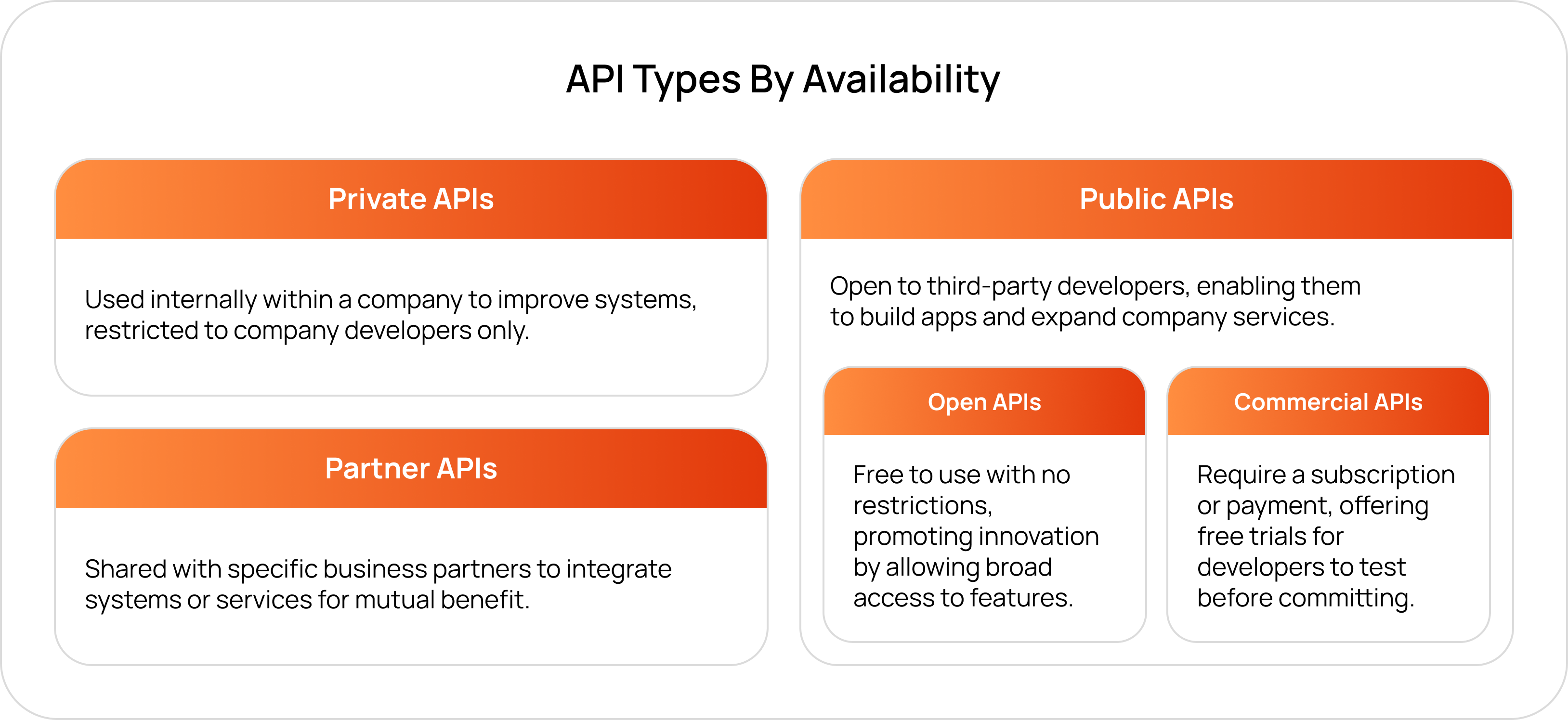Even if you’re not part of the tech world or don’t have an IT background, you’ve likely heard of APIs. They’re everywhere — in the weather app you use to check if it’s going to rain and in your favorite booking service as you plan your next trip. But what exactly do they do? APIs serve as invisible bridges between digital platforms, allowing them to connect and communicate seamlessly with one another.
In fact, nearly 65% of organizations rely on APIs to improve collaboration with partners and foster innovation, while 60% share APIs internally to accelerate product and service delivery.
In this article, we’ll break down what APIs are, how they work, and why they’re essential, not just for the tech industry but for businesses looking to stay competitive in today’s digital landscape.
Benefits and Concerns of API Integration
APIs provide many benefits for businesses, from streamlining workflows to enhancing customer experiences. Here are some key advantages:
Eliminate Data Silos
APIs integrate disparate systems, ensuring that employees have access to the data they need directly within the applications they already use. This eliminates the need for manual data searches or reliance on other departments or IT for data retrieval. The result is smoother workflows and faster decision-making as data becomes easily accessible across the organization.
Prevent Human Errors
Manual data entry tasks are prone to mistakes, such as incorrect data being copied from one system to another. APIs automate data transfers between systems, reducing the likelihood of human error. This leads to more accurate data, avoiding costly mistakes like entering the wrong contact details, which could harm relationships with customers or prospects.
Improve Employee Productivity
By reducing the need for manual tasks like copying and pasting data, APIs free up time for employees to focus on higher-value work. This not only boosts productivity but also enhances job satisfaction as employees can concentrate on tasks that require critical thinking, leading to improved overall performance and morale.
Support Business Agility and Innovation
APIs allow businesses to integrate new functionalities or services without overhauling entire systems. This enables quicker innovation and adaptation to market changes. Companies can rapidly develop new features, integrate third-party services, or pivot to meet customer demands—all of which contribute to staying competitive in fast-paced industries.
How APIs Work Behind the Scenes
To better understand APIs and their role, let’s start with a simple analogy. Imagine you’re planning a vacation. You need to book flights, reserve hotel rooms, and maybe even schedule tours or rent a car. Instead of contacting each airline, hotel, or tour company individually, you go to a travel agent. The agent knows how to access all these systems, retrieve the options that suit your preferences, and make the reservations for you, saving you time and effort.
In the digital world, APIs operate much like that travel agent. They enable one application to communicate with another, exchanging data seamlessly. Just as a travel agent interacts with various booking systems on your behalf, an app relies on APIs to request data or services from other applications or systems, so it doesn’t have to handle everything on its own.
Here’s a look at how it works behind the scenes. When an app needs information or services, it sends a request to an API. This request travels over the internet, often using protocols like HTTP or HTTPS—the same ones your browser uses to load websites. The request specifies what the app needs to do, such as:
- GET: Retrieve information, like flight schedules or hotel availability.
- POST: Submit data, such as payment details for a reservation.
The request also includes any necessary parameters (e.g., destination, travel dates) and authentication details, like an API key, which verifies the app’s identity.
The API then checks the request and, if authorized, processes it. It might interact with a database to fetch the required data or perform the requested action. Once complete, the API sends a response, usually formatted in JSON or XML, providing the requested data or confirming the operation’s success or failure.

Let’s go back to the vacation planning example to see how this works in a real-world scenario. When you use a travel booking app to organize your trip, the following steps occur:
- The app sends a request to an API (e.g., from an airline, hotel, or car rental service) to check availability and pricing based on your criteria.
- The API processes the request, interacts with the service’s systems (and possibly a database), and retrieves the relevant data.
- The data is then sent back to the app in a format it can understand, like JSON.
- Finally, the app processes this data and displays the available options for you to choose from.
This entire process happens in seconds, connecting you to multiple services without requiring you to visit each provider individually. While the app might appear simple from your perspective, APIs are managing the complex communication and data retrieval behind the scenes, ensuring a seamless and efficient user experience.
Types of APIs
Now that we’ve explored how APIs work, let’s dive a little deeper to discover the different types of APIs available. Knowing these distinctions helps businesses and developers choose the right type of API to meet their needs.
APIs can be classified in several ways, depending on who can access them and their intended purposes. Here are the most common types of APIs, categorized by accessibility and use:
APIs by Availability
APIs can be divided into three primary categories based on who can access them: private, partner, and public.
Private APIs
These are internal tools used by a company’s own developers to improve its systems and services. While the apps using these APIs may be public, the API itself is restricted to people within the company. This allows businesses to maintain control over their technology and usage.
Partner APIs
Shared with specific business partners through agreements, these APIs are used to integrate systems or services between companies. This helps businesses work together more effectively and serve their mutual customers.
Public APIs
Also known as external or developer-facing APIs, these are open to third-party developers, enabling them to build apps that work with the company’s services. Public APIs help companies grow by reaching more users and creating new revenue streams.
Public APIs can further be divided into two types:
- Open APIs: Free to use without restrictions, open APIs encourage innovation by allowing developers to access the API’s features and documentation without requiring approval.
- Commercial APIs: These APIs require a subscription or payment to use. Many offer free trials, so developers can explore their features before committing to a paid plan.

APIs by Use Case
APIs can also be categorized based on the tasks they perform or the systems they interact with. Here are a few common types:
Database APIs
These allow applications to interact with databases, enabling them to retrieve or update information. For example, a database API lets an app ask a database for specific data, such as customer details or product information, and then use that data within the app.
Operating System APIs
These provide access to underlying operating system functions, such as managing files or interacting with hardware. For example, an app on a Windows computer might use a Windows API to access system resources, or an iPhone app would use an API designed for iOS to interact with the device’s features.
Remote APIs
These APIs allow applications to access resources on another machine over a network, such as the internet. This is particularly useful for applications that need to interact with services or databases located elsewhere.
Web APIs
The most common type, Web APIs enable web applications to communicate with servers over HTTP. Web APIs help apps request data or services from servers and return the response in a format like JSON, which the app can display to users.

API Formats and Specifications
Now that we’ve covered the types of APIs, let’s explore their formats and specifications. APIs come in various formats, each with its own strengths and use cases. These formats define how data is exchanged between systems, ensuring compatibility across platforms that may use different programming languages, operating systems, or technologies. This standardization is what makes APIs so powerful, enabling seamless communication in diverse digital environments.
The most commonly used API formats are:
- SOAP (Simple Object Access Protocol)
- REST (Representational State Transfer)
- GraphQL
- RPC (Remote Procedure Call)
In future articles, we’ll dive deeper into these formats, compare their strengths and weaknesses, and explore key aspects like API documentation and requirements, so stay tuned.
Examples of APIs in Action
Having covered the technical side of APIs, let’s take a look at how they operate in the real world. APIs are behind many of the popular services we use daily, enabling seamless communication and functionality across platforms. Let’s explore some examples to see how APIs power the digital experiences we rely on.
Google Maps API
The Google Maps API allows developers to integrate Google’s mapping features into their apps and websites. For example, when you open a delivery app and see a map showing your location and the best route, that’s the Google Maps API at work. The app sends requests to Google’s servers for map data, traffic information, and route optimization, which are then displayed in the app.
Spotify API
With Spotify’s API, other apps and devices, like Amazon Alexa and Google Home, can access Spotify’s music features. Through the API, apps can request playlists, stream music, and even create new playlists based on user preferences.
Twitter API
The Twitter API enables third-party applications to interact with Twitter data. For example, news websites may use it to display the latest tweets or hashtags related to current events. Similarly, analytics tools can gather data on tweet performance and engagement, all via the Twitter API.
Conclusion
APIs are the backbone of modern digital experiences, enabling seamless communication between systems, platforms, and services. For businesses, understanding and leveraging APIs can unlock countless opportunities for growth, efficiency, and innovation. By integrating APIs, businesses can enhance their services, improve user experiences, and extend their capabilities without reinventing the wheel. Whether you’re looking to connect with third-party services, streamline internal processes, or expand your reach, APIs are an essential tool to stay competitive in today’s digital landscape.
If you have a project idea in mind and need expert guidance on building custom APIs or integrating existing ones, Softarex is here to help. Our team of experienced developers can help bring your vision to life and provide the technical support you need. Contact us today to discuss your project and discover how we can help you make the most of APIs for your business.









